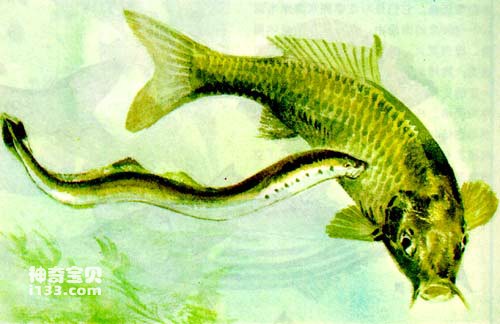Lampreys look very much like ordinary eels. They have a slender body with exposed skin without scales. There is a long dorsal fin on its back, which extends back to the tail end and surrounds the tail to form a caudal fin. In addition, it has no other parts on its body. No other fins are present. Lampreys have only one nostril, located between the eyes on their head. It has seven gill openings on each side of its body behind its eyes, which is why it is called a "lamprey".

lamprey
The mouth of the lamprey is very strange, round like a suction cup, and filled with sharp teeth, but it has no jaw structure. During the early stages of its ontogeny, the lamprey lives in the bottom waters of rivers or lakes, sucking up small animals with its sucker-like mouth. When it is fully developed, its lifestyle changes to a parasitic life. It uses its sucker-shaped mouth to attach to the bodies of other fish, and then uses its sharp, file-like teeth to file a hole in the host's body, and then burrows into the host's body. Suck blood. Sometimes, the lamprey abandons the host before it dies and finds a new victim; other times, the lamprey remains parasitized in the fish until it bleeds to death.
In fact, lampreys are extremely specialized relics of some of the earliest vertebrates on earth - jawless animals. Their specialization is reflected in many aspects. For example, they have no bony skeleton or armor, apparently the result of bone degradation in adaptation to parasitic life. However, we can still get a glimpse of the state of the earliest jawless vertebrates from the very primitive general characteristics of the lamprey.
The lamprey also has a close relative called the hagfish, which has degenerated so much that it has no eyes. They are all vertebrates without jaw structures and belong to the class Agnathids, which are very similar to the earliest jawless vertebrates that appeared on the earth. Through lampreys, we can roughly imagine the appearance and living conditions of those ancient vertebrates more than 500 million years ago.
animal tags: lamprey hagfish eel
We created this article in conjunction with AI technology, then made sure it was fact-checked and edited by a Animals Top editor.